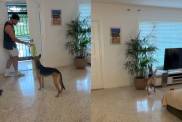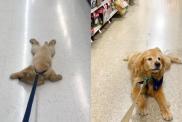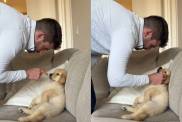Question:
We’re bringing home a new Lab mix this week. She’s already met our current dog, a Shepherd mix, and they get along great. Is there anything we can do to make sure the dogs share toys and reduce the chance of potential squabbles?
Answer:
While to a large degree the dogs themselves are going to decide how well they get along, there are a few basic things you can do to smooth things along.
Even if the dogs have had one or more successful meetings before the new one comes home to stay, you’ll want to be sure that the first day home goes as well as possible. Rather than just bringing the new dog into the house, meet outside on “neutral” territory and take a nice long walk as a group. (Each dog has his own person.) This walk will give them a chance to become accustomed to seeing and smelling each other. This is not a chance to meet on leash…just a walk side-by-side.
After the walk, bring the new dog into the house first, followed by your current dog and then let them meet and greet, only after they are off leash. Keep this meeting and the meetings for the next few days short–starting with a few minutes at a time and gradually working up to an hour or more.
Dogs need to have their own “space,” which is why I am a proponent of crates: especially for multi-dog households. Even if you are planning on allowing the dogs to sleep outside of their crates or have the run of the home when you are away, crates are useful when dogs need a little “alone time.” It’s a good idea to start to condition your current dog to being alone in the crate with Kongs or other “food toys” so they start to get the idea that things can be good when they are alone. If you are really dead set against using crates, set aside rooms or areas blocked off with baby gates or exercise pens.
Be careful with leaving toys out. Start put with only a few and only let them play around the toys under supervision. It’s can be difficult which dogs will guard toys and under what circumstances. Some dogs seemed prepared to guard anything and everything, while others will only guards toys under very specific circumstances.
When the dogs are together look out for the following trouble signs:
- One dog is guarding toys or food bowls from another. This is a serious issue that can rapidly escalate. Immediately separate the dogs and/or remove the toys and start feeding them separately. Consult a trainer for help.
- Your dogs seem to be watching or staring at each other very often.
- Your dogs are frequently up on their back paws during play. This is a sign that play is starting to get too serious.
- One dog is pushing the other out of the way in order to get attention or petting from you or seems upset and jealous when you pay attention to the other dog.
- Your dogs display “stiff” body postures around each other. (Generally speaking a stiff body posture is never good.)
- One dog seems to be avoiding the other and seems submissive and low to the ground when near him.
This seems like a lot to worry about, but it really shouldn’t frighten you. There are many multiple dog households that live in peace and harmony. It’s simply a matter being proactive and keeping aware of how your dogs interact.









